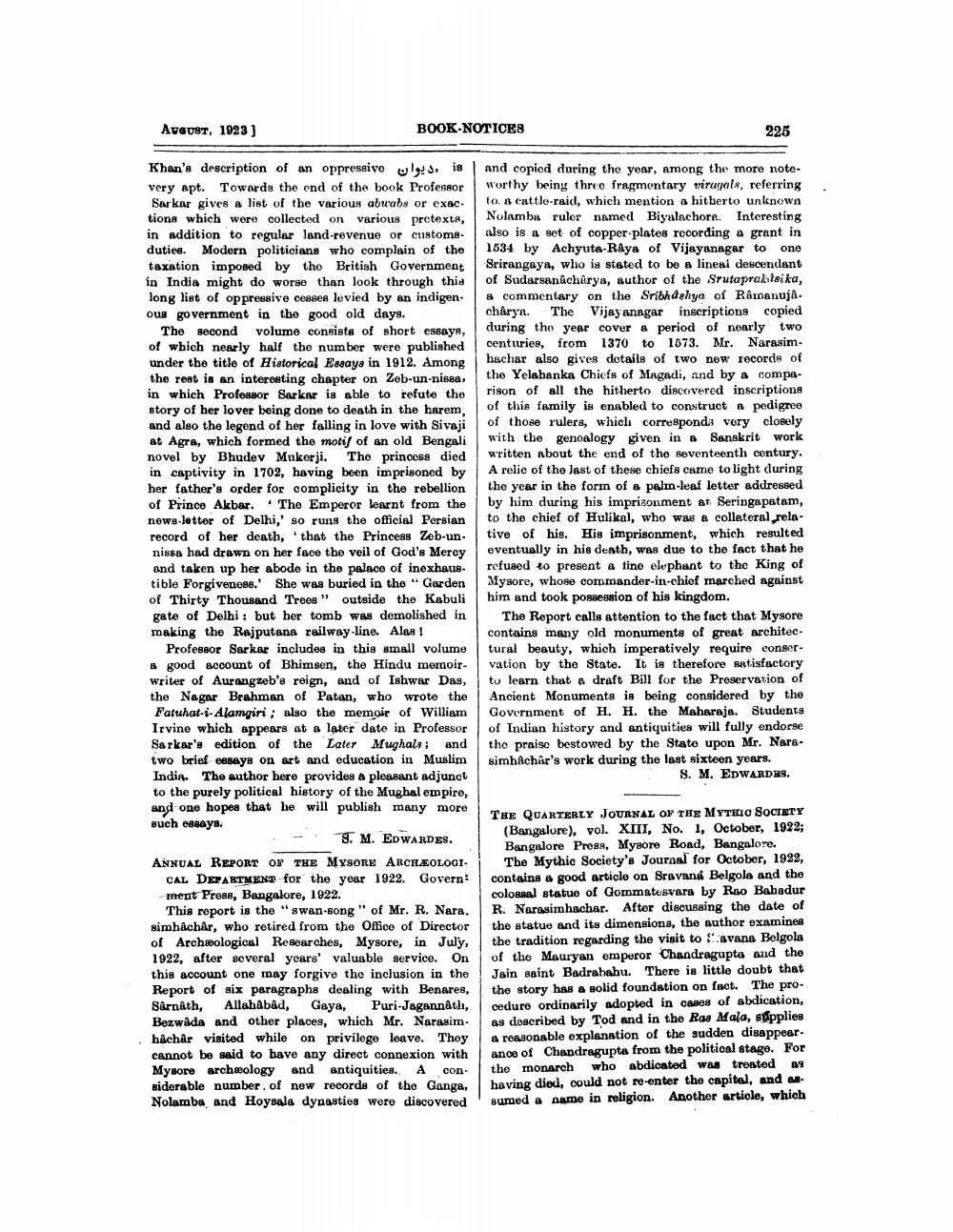________________
AUGUST, 1923]
13, is
Khan's description of an oppressivo very apt. Towards the end of the book Professor Sarkar gives a list of the various abwabs or exactions which were collected on various pretexts, in addition to regular land-revenue or customsduties. Modern politicians who complain of the taxation imposed by the British Government in India might do worse than look through this long list of oppressive cesses levied by an indigenous government in the good old days.
BOOK-NOTICES
The second volume consists of short essays, of which nearly half the number were published under the title of Historical Essays in 1912. Among the rest is an interesting chapter on Zeb-un-nissa, in which Professor Sarkar is able to refute the story of her lover being done to death in the harem, and also the legend of her falling in love with Sivaji at Agra, which formed the motif of an old Bengali novel by Bhudev Mukerji. The princess died in captivity in 1702, having been imprisoned by her father's order for complicity in the rebellion of Prince Akbar. The Emperor learnt from the news-letter of Delhi,' so runs the official Persian record of her death, that the Princess Zeb-unnissa had drawn on her face the veil of God's Mercy and taken up her abode in the palace of inexhaustible Forgiveness.' She was buried in the "Garden of Thirty Thousand Trees" outside the Kabuli gate of Delhi: but her tomb was demolished in making the Rajputana railway-line. Alas!
Professor Sarkar includes in this small volume a good account of Bhimsen, the Hindu memoirwriter of Aurangzeb's reign, and of Ishwar Das, the Nagar Brahman of Patan, who wrote the Fatuhat-i-Alamgiri; also the memoir of William Irvine which appears at a later date in Professor Sarkar's edition of the Later Mughals; and two brief essays on art and education in Muslim India. The author here provides a pleasant adjunct to the purely political history of the Mughal empire, and one hopes that he will publish many more such essays.
S. M. EDWARDES. ANNUAL REPORT OF THE MYSORE ARCHEOLOGICAL DEPARTMENT for the year 1922. Govern ment Press, Bangalore, 1922.
This report is the "swan-song" of Mr. R. Nara. simhachar, who retired from the Office of Director of Archæological Researches, Mysore, in July, 1922, after several years' valuable service. On this account one may forgive the inclusion in the Report of six paragraphs dealing with Benares, Sarnath, Allahâbâd, Gaya, Puri-Jagannâtli, Bezwada and other places, which Mr. Narasimhâchâr visited while on privilege leave. They cannot be said to have any direct connexion with Mysore archæology and antiquities.. A considerable number, of new records of the Ganga, Nolamba and Hoysala dynasties were discovered
225
and copied during the year, among the more noteworthy being three fragmentary virugals, referring to. a cattle-raid, which mention a hitherto unknown Nolamba ruler named Biyalachore. Interesting also is a set of copper-plates recording a grant in 1534 by Achyuta-Râya of Vijayanagar to one Srirangaya, who is stated to be a lineal descendant of Sudarsanâcharya, author of the Srutaprakisika, a commentary on the Sribhashya of Ramanuja. charya. The Vijayanagar inscriptions copied during the year cover a period of nearly two centuries, from 1370 to 1573. Mr. Narasimhachar also gives details of two new records of the Yelahanka Chiefs of Magadi, and by a comparison of all the hitherto discovered inscriptions of this family is enabled to construct a pedigree of those rulers, which corresponds very closely with the genealogy given in a Sanskrit work written about the end of the seventeenth century. A relic of the last of these chiefs came to light during the year in the form of a palm-leaf letter addressed by him during his imprisonment at Seringapatam, to the chief of Hulikal, who was a collateral relative of his. His imprisonment, which resulted eventually in his death, was due to the fact that he refused to present a tine elephant to the King of Mysore, whose commander-in-chief marched against him and took possession of his kingdom.
The Report calls attention to the fact that Mysore contains many old monuments of great architectural beauty, which imperatively require conservation by the State. It is therefore satisfactory to learn that a draft Bill for the Preservation of Ancient Monuments is being considered by the Government of H. H. the Maharaja. Students of Indian history and antiquities will fully endorse the praise bestowed by the State upon Mr. Narasimhachar's work during the last sixteen years. S. M. EDWARDES.
THE QUARTERLY JOURNAL OF THE MYTHIC SOCIETY (Bangalore), vol. XIII, No. 1, October, 1922; Bangalore Press, Mysore Road, Bangalore. The Mythic Society's Journal for October, 1922, contains a good article on Sravaná Belgola and the colossal statue of Gommatesvara by Rao Bahadur R. Narasimhachar. After discussing the date of the statue and its dimensions, the author examines the tradition regarding the visit to avana Belgola of the Mauryan emperor Chandragupta and the Jain saint Badrabahu. There is little doubt that the story has a solid foundation on fact. The procedure ordinarily adopted in cases of abdication, as described by Tod and in the Ras Mala, supplies a reasonable explanation of the sudden disappear. ance of Chandragupta from the political stage. For the monarch who abdicated was treated as having died, could not re-enter the capital, and as. sumed a name in religion. Another article, which




